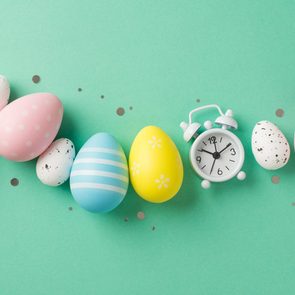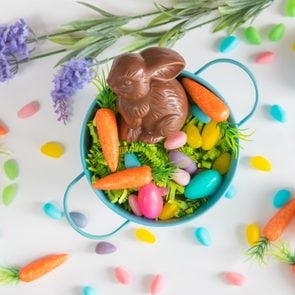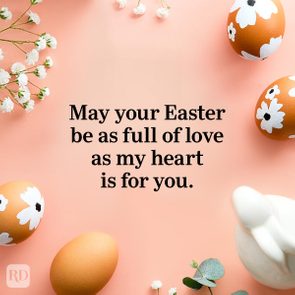What Are the Easter Colors, and What Do They Mean?
Updated: Apr. 06, 2024
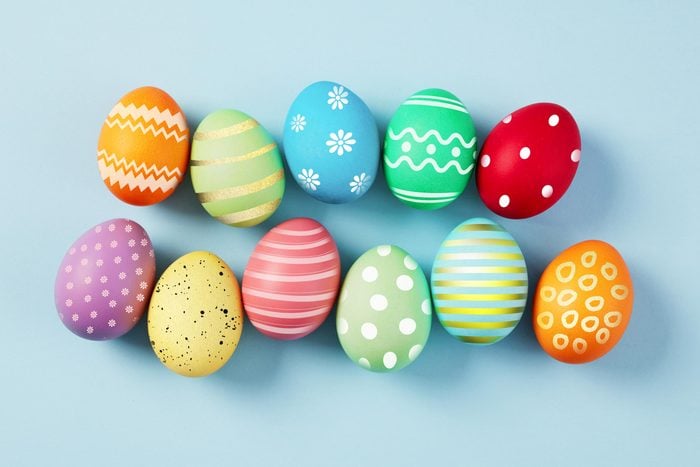
Easter has a signature set of colors—and the traditional pairing might surprise you!
Easter is known for being a colorful holiday—bursts of springtime hues adorn Easter crafts, clothing and home decor. But beyond the palette of pastels that probably comes to mind, are there actual Easter colors? The short answer is yes! This Christian holiday has its own very specific color scheme … though some of its most prominent colors are not what you might think.
Reader’s Digest asked Paul T.P. Wong, PhD, a Christian clinical psychologist and professor emeritus at Trent University and Trinity Western University, to lead us through the details of this paschal puzzle. Ahead, learn the nuances of Easter’s most symbolic shades and how they can make your holiday even more meaningful.
Get Reader’s Digest’s Read Up newsletter for more holidays, humor, travel, tech and fun facts all week long.
About the expert
|
Why does Easter have so many colors?
As one of the two most important Christian holidays, Easter has many meanings—and they’re not all religious. This holiday also has historical, cultural and personal significance, especially since it’s intertwined with springtime. Because of this, Wong says, it makes sense that Easter has more symbolic colors than other holidays.
There may also be an economic reason at play: Signature colors help companies market and brand products related to a holiday. And there’s no mistaking the shift from stores’ red aisles filled with Valentine’s Day gifts to pastel-strewn ones packed with Easter goodies.
The two main colors of Easter
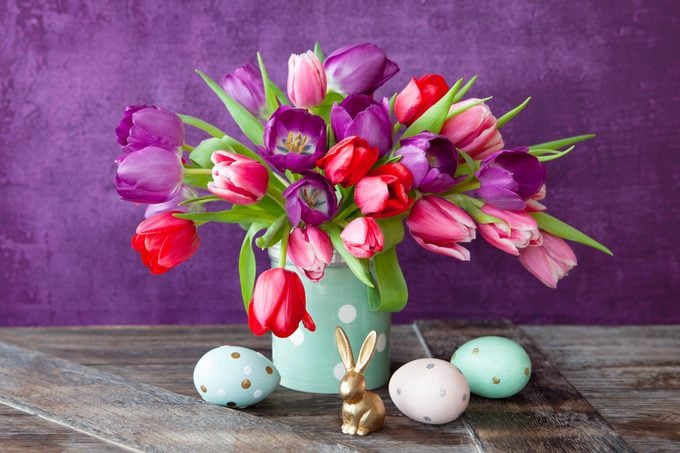
Christmas has red and green, Halloween has black and orange, Valentine’s Day has red and pink, and St. Patrick’s Day has green and, well, more green. So what is the classic color pairing for Easter? Red and purple, Wong says. Surprised? We were too!
“When you look at the religious and historical roots of Easter, red stands for the passion of Christ and the sacrificial blood he shed to pay for the penalty of our sins, while purple is a mark of royalty and recognizes Christ as king,” Wong explains. “This is why, in mocking Jesus before his crucifixion, the Roman soldiers dressed Jesus in a purple robe, put a crown of thorns on his head and yelled, ‘Hail, king of the Jews!'”
What are all the Easter colors, and what do they mean?
Red and purple may historically represent Easter, but today’s celebrations incorporate a wide range of colors, particularly those representing springtime. This is likely due to early Christians combining the Easter celebration with pagan celebrations that were centered around the spring equinox. In fact, many popular Easter traditions are a legacy of these ancient rituals, including Easter baskets, flower crowns and egg hunts. And many historians believe that Easter was named after one of the more popular figures in these celebrations: the Anglo-Saxon goddess of fertility, Eostre.
So what we now think of as traditional Easter colors—pink, yellow, green, white, blue and pastels of all shades—represent these themes of planting, sunshine, renewal, growth and fertility, as well as spring conquering winter and darkness. Here’s an in-depth explanation of each color.
Red
Traditionally, this deep hue represented the sacrificial blood of Jesus, Wong says. As a result, you’ll see it more in religious Easter ceremonies, like a special church service, than you will in mass-marketed Easter products. Red also represents courage and change—two things people may be contemplating at this time of year, especially during Lent.
Purple
This royal hue reminds us of the royalty and divine mission of Jesus, which makes it another popular choice for church decorations at Easter time, Wong says. Deep purples are also found in the very first flowers to bloom in springtime, with hyacinths and crocuses poking their heads up through the snow. For this reason, this shade of purple may also represent resilience and strength during difficult times.
Light pink
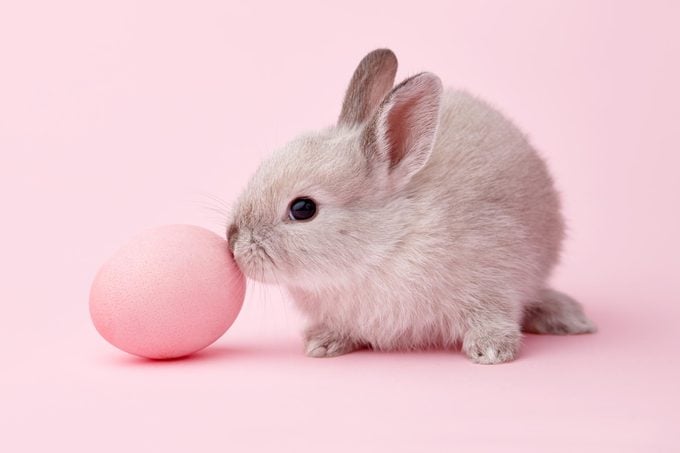
This sweet shade represents love—but not the romantic kind. The lighter pinks of Easter are those of newborn babies, tulips, early strawberries and blossoming trees, and they’re symbolic of new life, youthful innocence and sweetness.
Yellow
Called “the happiest color,” bright yellow and gold appear in the flowers, sunshine and clothing of springtime. This sunny hue is symbolic of the light that conquers the darkness and may also represent the other type of son, as in Jesus Christ, the son of God.
Green
Green is the earliest ambassador of the arrival of spring and signals the end of winter, making green a popular color for Easter, Wong says. Green grass (in your yard or Easter baskets), green shoots of vegetables or flowers, and green buds on trees represent new life, so wearing or decorating with similar shades can symbolize a desire for growth and new beginnings.
White
White represents purity, both in the sacrifice of Christ and in earlier pagan celebrations, so decorating with this pure color symbolizes virtue and cleanliness. It also symbolizes the triumph of good over evil, one of the main themes of Easter, Wong says.
Serene blue
Sky blue, robin’s-egg blue and cornflower blue are all hallmarks of spring, making them hugely popular colors to dye eggs, put in bouquets and wear at Easter time. These calm shades of blue symbolize peace, tranquility and wisdom, according to Color Psychology, an organization devoted to cataloging colors, their meanings and how they affect people.
Lavender
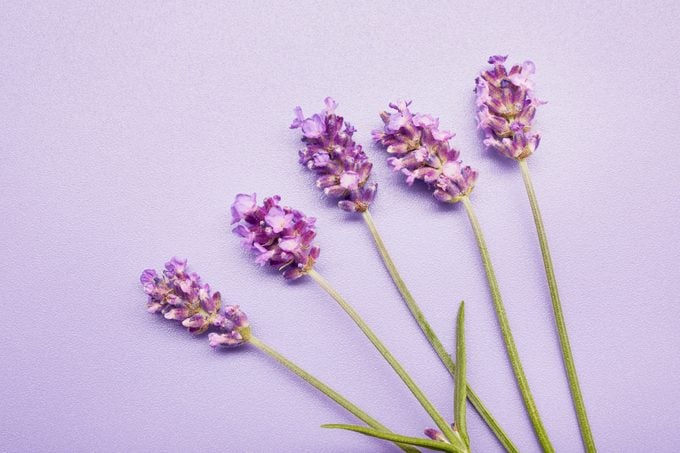
These notably fragrant flowers start blooming early in the spring, covering fields in their stunning shade of light purple. This color symbolizes youth and creativity, and because of its association with springtime, it also represents optimistic beginnings and new stages of life, according to Color Psychology. From a religious standpoint, lavender embodies devotion, serenity and grace—all characteristic of Easter.
Pastels
Pastels are unique to the Easter holiday, probably because they are so prevalent in nature in springtime. These light shades are a welcome relief to the darker shades that dominated fall and winter, and they symbolize new life, gentleness and grace. In addition, Wong says, “pastels may symbolize the joy of Mary Magdalene and the other women when they discovered that the tomb that buried Jesus was empty on Easter Sunday,” since these women are often depicted wearing pastel clothing in artistic portrayals of the scene.
Happy Easter!
Regardless of how you and your loved ones choose to celebrate Easter this year, the colors you choose can make a big impact. Now that you know what they mean, you can make sure you’re creating just the right atmosphere. So who’s ready to make some Easter baskets?
Why trust us
At Reader’s Digest, we’re committed to producing high-quality content by writers with expertise and experience in their field in consultation with relevant, qualified experts. For this piece, we relied on reputable primary sources, including Paul T.P. Wong, PhD, a Christian clinical psychologist, a professor emeritus and the founding pastor of Toronto’s first Chinese Gospel Church. We verify all facts and data, back them with credible sourcing, and revisit them over time to ensure they remain accurate and up to date. Read more about our team, our contributors and our editorial policies.
Sources:
- Paul T.P. Wong, PhD, Christian clinical psychologist, professor emeritus at Trent University and Trinity Western University, and president of the International Network on Personal Meaning; email interview, Feb. 14, 2024
- Farmers’ Almanac: “The Secret Meanings of Colors”
- History.com: “Easter 2024”
- Color Psychology

